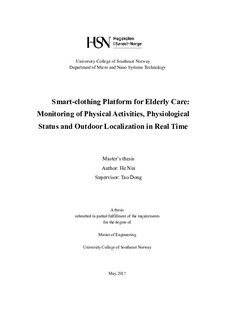Smart-clothing Platform for Elderly Care: Monitoring of Physical Activities, Physiological Status and Outdoor Localization in Real Time
Master thesis
Permanent lenke
http://hdl.handle.net/11250/2474377Utgivelsesdato
2017Metadata
Vis full innførselSamlinger
Sammendrag
The emerging research on smart clothing platform in health monitoring field has been a great concern both in academia and products industry. And with the problem of global population aging, the need for more services with higher quality in eldercare environment is poised to become significant. Advances in micro technologies, flexible sensors and related technologies make a new smart clothing can be developed to enhance the efficiency of eldercare, illness and unpredictable event prevention with monitoring and alarming method.
This master thesis provides a design of a smart-clothing platform based on embedded and wearable technology, which is a continuous monitoring to track the physical activities, physiological status and achieves automatic outdoor positioning for the elderly. Based on sensor network technology and Qt Creator development environment, the platform uses a greater number of sensor nodes to detect the different parts of the body to improve the detection accuracy. Front-end system uses STC12C5A60S2 microcontroller as the central node to receive the data of each sub-node, and through the wireless network data transfer to the PC for analysis. PC research algorithm to deal with the relevant data. Finally, the human-computer interface display and store results. Compared with traditional smart clothing, this system can provide a multifunctional specialization monitoring for elderly who need extra cares.
This thesis is organized as follows. Chapter 1is an introduction including the smart clothing concept, the review of previous works, motivations, and the objectives of this thesis is also given in this chapter. Chapter 2 introduces system functions and the whole design scheme which covers both the hardware and software design. In chapter 3, the advanced relevant algorithms used for posture recognition is presented in order to provide the necessary knowledge, and the final algorithm used in this thesis is explained in this chapter. The chapter 4 and 5 respectively introduce the system hardware implementation and the software implementation. The system consists of wearable nodes (6 subnodes and 1 central node) and PC human-computer interaction interface, which are explained in detail in both chapters. Chapter 6 shows the experimental results of this smart-clothing platform and analyzes them in turn. On the basis of Chapter 6, Chapter 7 concludes the advantages and disadvantages of this system and gives the recommendations for future works. Additionally, the software source code of host computer and the lower computer are given in the appendix
